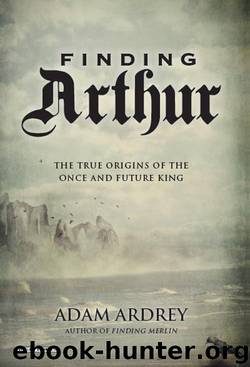Finding Arthur: The True Origins of the Once and Future King by Adam Ardrey

Author:Adam Ardrey
Language: eng
Format: mobi
Tags: Europe, BIO000000, Social Science, BIO014000, HIS000000, HIS015000, Great Britain, BIO006000, History, Folklore & Mythology, Medieval
ISBN: 9781468306897
Publisher: Overlook
Published: 2013-10-16T18:00:00+00:00
Having placed his bare foot in the stone—according to John McLeod in his book Highlanders—the Lord of the Isles then turned “sunwise” three times, taking in the four points of the compass, while brandishing the sword to the acclaim of all. 17 It has long been supposed that footprints carved into rocks were part of pre-Christian inauguration ceremonies, symbolizing the king’s union with the land and so with his people. There are two footprints at Clickhimin, Shetland; there was one outside the church at Wedale in the borders (where Arthur fought and won a battle against the Angles), and we must suppose there was a footprint somewhere in the Lordship of the Isles. It may reasonably be inferred that something similar to the events that occurred when a Lord of the Isles was inaugurated occurred at Dunadd in 574 when Aedan was made king.
In 574 Aedan was inaugurated king of the Scots when he sat on the Stone of Destiny on the summit of Dunadd before the people of Dalriada. He then placed his foot in the footprint shape carved into the stone and brandished a sword to the four points of the compass, while his supporters (and those who thought it wise to pretend to be his supporters) cheered his elevation. A bard then recited his lineage to demonstrate to all present his “right” to the throne, even though no one could have been in any doubt that Aedan’s inauguration was only taking place because of his military might.
Aedan cannot have forgotten that his great-grandfather Fergus died within a year of becoming king of the Scots and that Fergus’s successor, Aedan’s grandfather, Domangart, was dead some six years after that. Aedan’s father, Gabhran, had died soon after defeat in battle, probably of his wounds. Aedan must have known that being a king of the Scots was a dangerous business, even when that king was universally recognized and there was no internal opposition.
He must also have known that he would soon have to fight to secure his throne and so he would also have appreciated how important it was to have a recognized successor if there was to be a smooth succession in the event of his death. There was also the real danger of assassination. This could be lessened if, in the event of his death, it was accepted that his tanist would succeed and that consequently nothing would change to the advantage of the assassin’s party.
Download
This site does not store any files on its server. We only index and link to content provided by other sites. Please contact the content providers to delete copyright contents if any and email us, we'll remove relevant links or contents immediately.
Cecilia; Or, Memoirs of an Heiress — Volume 1 by Fanny Burney(32489)
Cecilia; Or, Memoirs of an Heiress — Volume 2 by Fanny Burney(31909)
Cecilia; Or, Memoirs of an Heiress — Volume 3 by Fanny Burney(31887)
The Great Music City by Andrea Baker(31752)
We're Going to Need More Wine by Gabrielle Union(18997)
All the Missing Girls by Megan Miranda(15760)
Pimp by Iceberg Slim(14433)
Bombshells: Glamour Girls of a Lifetime by Sullivan Steve(14019)
For the Love of Europe by Rick Steves(13491)
Talking to Strangers by Malcolm Gladwell(13284)
Norse Mythology by Gaiman Neil(13268)
Fifty Shades Freed by E L James(13184)
Mindhunter: Inside the FBI's Elite Serial Crime Unit by John E. Douglas & Mark Olshaker(9258)
Crazy Rich Asians by Kevin Kwan(9214)
The Lost Art of Listening by Michael P. Nichols(7450)
Enlightenment Now: The Case for Reason, Science, Humanism, and Progress by Steven Pinker(7270)
The Four Agreements by Don Miguel Ruiz(6693)
Bad Blood by John Carreyrou(6580)
Weapons of Math Destruction by Cathy O'Neil(6204)
